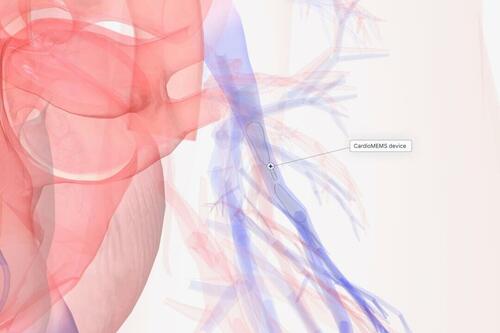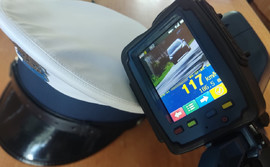
A Paper Clip-Sized Device Is Changing Heart Failure Treatment
Authored by Robin Seaton Jefferson via The Epoch Times (emphasis ours),
A tiny device, no bigger than a paper clip, may be improving the lives of heart failure patients.
Implanted in the pulmonary artery, this wireless sensor allows doctors to detect fluid buildup weeks before symptoms appear. When the heart is unable to pump enough blood to meet the body’s needs, fluid builds up in the surrounding tissue. For millions suffering from congestive heart failure, this early warning system may mean fewer emergency room visits, reduced hospitalizations, and improved quality of life.
 aipicte/Shutterstock
aipicte/Shutterstock“I think it’s huge,” Dr. Liviu Klein, a cardiologist at the University of California, San Francisco (UCSF) Medical Center, told The Epoch Times. “We have something now to avoid hospitalizations. If people are healthier at home, they live longer.”
Though the term “heart failure” sounds like the heart has stopped working, the condition is chronic and can drag on for years, draining patients physically, emotionally, and financially. But the constant fear of the next crisis can overshadow everything else, Klein said.
While CHF can not be cured, it can be managed with multiple medications, diet restrictions, and daily weight checks. Still, sometimes the patient struggles to breathe.
“By the time they realize what’s happening, it’s already too late to take a pill,” Klein said. “They need an IV.”
Small Sensor, Big Impact
The CHAMPION trial, a clinical study, beginning in 2007, marked a significant milestone in heart failure treatment, Klein said, because before this trial, the remote hemodynamic management of heart failure did not exist. This trial showed that the device reduced repeat hospitalizations in heart failure patients by nearly 40 percent. Klein participated in the multi-center trial, involving 550 subjects across 64 U.S. sites, as a site co-investigator at Northwestern Memorial Hospital in Chicago and as the principal investigator at the University of California at San Fransisco in the post-approval study.
The study’s results, published in 2010 in the Journal of Cardiac Failure, led to the development of a microelectromechanical system, called CardioMEMS. Interventional cardiologist, Dr. Jay S Yadav, founded the CardioMEMS company in 2001 to develop new devices for treating chronic cardiovascular diseases such as heart failure.
The CardioMEMS heart failure monitoring device was co-invented by Dr. Yadav and Mark Allen, a professor at Georgia Tech’s School of Electrical and Computer Engineering and the director of the school’s MEMS research group. Approved by the U.S. Food and Drug Administration (FDA) in 2014, CardioMEMS has since been implanted in over 35,000 heart failure patients.
The UCSF Medical Center was among the first in the United States to adopt the technology, according to Klein. “I have placed hundreds since [2014],” he said. “We have seen in our own patients what clinical studies have shown,” he added. “We have seen a reduction in clinic visits.” This is particularly beneficial for older patients who often travel long distances for doctor visits, Klein noted.
Early Warning System
The CardioMEMS is a dime-sized sensor implanted into a heart failure patient’s pulmonary artery through a minimally invasive procedure. This device measures and records pulmonary artery pressure, providing crucial information about the heart’s performance and blood flow to organs. Changes in pulmonary artery pressure can signal worsening heart failure before symptoms appear.
The outpatient procedure for implanting the device takes only 30 to 40 minutes. Once implanted, patients can easily monitor their condition at home using a special pillow equipped with an antenna. Patients are advised to lie on the pillow at the same time every day for about 90 seconds. The pillow then communicates electronically with the implanted sensor, collecting heart and lung pressure data.
This information is then wirelessly transmitted to a secure website monitored by the patient’s cardiologist. If a change in pulmonary artery pressure is detected, a nurse calls the patient to give instructions from the doctor, which typically include medication changes.
Even small changes in pressure can have substantial effects on mortality rates, Klein said. For instance, a one-millimeter increase in pulmonary artery pressure raises mortality by 30 percent, while a two-millimeter decrease lowers it by 16 percent, he noted.
“We know what prolonged increased pulmonary artery pressure in the heart does. When pressures are high, the heart suffers. Every time this happens, there is an increased risk of mortality.”
Dr. Georges Chahoud, regional director of the Heart Failure Clinical Program in St. Louis, Missouri, told The Epoch Times that while the device doesn’t extend life expectancy, its significant impact on quality of life can. By dramatically reducing hospitalizations, it improves patients’ well-being, lightens the burden on health care providers, and lowers overall treatment costs. “It is a win-win for patients, providers, and insurance companies,” he added.
CardioMEMS Coverage Gap
According to Klein, CardioMEMS “should be used in patients who have had at least one hospital stay.” Patients may also be eligible for the system if they have been diagnosed with slight to marked limitations due to heart failure, and if they are able to take antiplatelet medications to prevent blood clots for at least one month after the sensor is implanted.
But even if a patient qualifies, it doesn’t mean private insurance or Medicare will pay for the device.
“About half of the Medical Administrative Contractors (MACs) in the U.S. cover the CardioMEMS,” Klein said, including California where his office is located. MACs are multi-state contractors responsible for administering both Medicare Part A and Medicare Part B claims in awarded regions.
Although Klein and others have witnessed a near-95-percent compliance rate, (95 percent of patients check their pressures three times per week, and 90 percent, five times a week), and some 20,000 to 30,000 patients nationwide have the device, Medicare still does not cover it everywhere.
“There are 6.5 million people in this country with heart failure,” Klein said. “There are still three-to-four million people who could benefit from it, but the coverage is not universal.”
On April 30, the Centers for Medicare and Medicaid Services (CMS) opened a National Coverage Analysis (NCA) and solicited public comments for 30 days, after Abbott and hundreds of physicians, hospital administrators, patients, professional societies and industry leaders requested consideration for CMS to create national coverage criteria to ensure coverage for all Medicare beneficiaries.
According to the CMS, the expected completion date for the NCA is Jan. 28, 2025. A proposed decision memo is due Oct. 30, 2024.
There has been significant support for this treatment, Klein said. Regulators will thoroughly review the clinical studies, economic analyses, and provider endorsements. If approved, private insurers are expected to quickly follow suit, he noted.
Heart Failure Cases on the Rise
Heart failure, affecting nearly 6 million Americans with almost a million new cases diagnosed every year, occurs when the heart can’t pump enough blood to meet the body’s needs.
As the heart weakens, fluid builds up in various parts of the body, leading to symptoms such as shortness of breath, weakness, swelling in legs, ankles, and feet, rapid or irregular heartbeat, cough, and difficulty concentrating.
Cardiologists tell patients tell patients to seek medical attention if symptoms worsen or if they experience rapid weight gain, as these could indicate worsening heart failure, Chahoud said.
Heart failure can result from various causes, including heart attacks, damaged valves, infections, high blood pressure, and even intense emotional stress or trauma (Broken Heart Syndrome). Also known as Takotsubo cardiomyopathy or stress-induced cardiomyopathy, Broken Heart Syndrome presents much like acute coronary syndrome but is often reversible. “The true broken heart syndrome is real,” Chahoud told The Epoch Times. “And it has the highest reversibility of CHF,” he added.
After years of decline, heart failure mortality rates have been increasing since 2012, especially among younger adults. A 2024 Duke University study reported that the mortality rate rose from 82 deaths per 100,000 people in 2012 to 106 in 2021. Experts attribute this trend to factors such as widespread obesity, rising rates of diabetes and hypertension, high costs of new heart medicines, and health care access difficulties, particularly during the COVID-19 pandemic.
Doctors treat heart failure with a combination of medicines known as the “four pillars:”
- Beta blockers
- Angiotensin receptor-neprilysin inhibitors (ARNIs)
- Mineralocorticoid receptor antagonists (MRAs)
- Sodium-glucose co-transporter 2 inhibitors (SGLT2i)
These medications help relax blood vessels, reduce heart workload, and improve pumping efficiency. In severe cases, heart valve surgery or implantable cardioverter defibrillators may be necessary.
What’s Next?
Heart failure is a multifaceted condition with many causes and a few treatments. Some types are reversible, others are life-long but manageable, Chahoud said, so early detection is crucial.
“The idea is to give an early signal to see the pressures going up two to four weeks before patients seek medical attention,” he said. “Then we can act on those early warnings.”
According to Drs. Chahoud and Klein, two more innovative devices are emerging as potential game-changers in heart failure management.
1. Cordella Pulmonary Artery Sensor System
In June, Endotronix, Inc.’s Cordella Pulmonary Artery Sensor System received FDA premarket approval for heart failure patients with limited physical activity. Led by Klein, the PROACTIVE-HF trial, which evaluated the Cordella system for safety and efficacy, demonstrated low heart failure hospitalization rates and significant improvements in patient’s quality of life and physical activity.
Cordella uses daily pressure and vital sign data to guide treatment decisions. The system includes a handheld pressure reader for patient self-monitoring. While available by prescription in the United States, it’s limited to clinical investigation in Europe.
2. Heart Failure and Arrhythmia Management System
ZOLL’s LifeVest wearable cardioverter defibrillator (WCD) was approved by the FDA in 2001. By 2010, physician prescriptions for the vest had topped 35,000. In 2019, the company introduced µCor (pronounced “Micro Core”) Heart Failure and Arrhythmia Management System (HFAMS), another new technology intended to improve the management of acute heart failure patients.
The non-invasive, patch-based wireless system monitors pulmonary fluid levels, alerting physicians to potential heart failure. The sensor can be worn for up to 30 days, transmitting data on heart rate, respiration, activity, posture, and heart rhythm.
A ZOLL-sponsored study showed that heart failure patients using the sensor were 38 percent less likely to be readmitted for complications within 90 days. By providing remote patient data, the device allows for earlier medication adjustments and complication prevention.
“Heart failure is a very large disease entity because there are a million causes for and types of it,” Chahoud said. “Some are reversible. Some are life-long, and some are easier to manage.”
Tyler Durden
Thu, 09/12/2024 – 21:00













![Krzysztof Sulima: Zrezygnowałem z gry w Stali. Do Anwilu po mistrzostwo [WYWIAD]](https://zkrainynba.com/wp-content/uploads/2025/04/sulima1-1024x683.webp)

